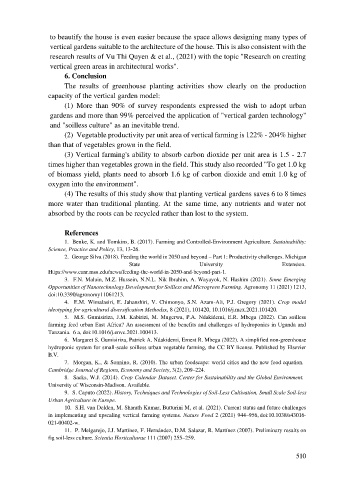Page 518 - Ebook HTKH 2024
P. 518
to beautify the house is even easier because the space allows designing many types of
vertical gardens suitable to the architecture of the house. This is also consistent with the
research results of Vu Thi Quyen & et al., (2021) with the topic "Research on creating
vertical green areas in architectural works".
6. Conclusion
The results of greenhouse planting activities show clearly on the production
capacity of the vertical garden model:
(1) More than 90% of survey respondents expressed the wish to adopt urban
gardens and more than 99% perceived the application of "vertical garden technology"
and "soilless culture" as an inevitable trend.
(2) Vegetable productivity per unit area of vertical farming is 122% - 204% higher
than that of vegetables grown in the field.
(3) Vertical farming's ability to absorb carbon dioxide per unit area is 1.5 - 2.7
times higher than vegetables grown in the field. This study also recorded "To get 1.0 kg
of biomass yield, plants need to absorb 1.6 kg of carbon dioxide and emit 1.0 kg of
oxygen into the environment".
(4) The results of this study show that planting vertical gardens saves 6 to 8 times
more water than traditional planting. At the same time, any nutrients and water not
absorbed by the roots can be recycled rather than lost to the system.
References
1. Benke, K. and Tomkins, B. (2017). Farming and Controlled-Environment Agriculture. Sustainability:
Science, Practice and Policy, 13, 13-26.
2. George Silva (2018). Feeding the world in 2050 and beyond – Part 1: Productivity challenges. Michigan
State University Extension.
Https://www.canr.msu.edu/news/feeding-the-world-in-2050-and-beyond-part-1.
3. F.N. Maluin, M.Z. Hussein, N.N.L. Nik Ibrahim, A. Wayayok, N. Hashim (2021). Some Emerging
Opportunities of Nanotechnology Development for Soilless and Microgreen Farming. Agronomy 11 (2021) 1213,
doi:10.3390/agronomy11061213.
4. E.M. Wimalasiri, E. Jahanshiri, V. Chimonyo, S.N. Azam-Ali, P.J. Gregory (2021). Crop model
ideotyping for agricultural diversification Methodsx, 8 (2021), 101420, 10.1016/j.mex.2021.101420.
5. M.S. Gumisiriza, J.M. Kabirizi, M. Mugerwa, P.A. Ndakidemi, E.R. Mbega (2022). Can soilless
farming feed urban East Africa? An assessment of the benefits and challenges of hydroponics in Uganda and
Tanzania. 6 a, doi:10.1016/j.envc.2021.100413.
6. Margaret S. Gumisiriza, Patrick A. Ndakidemi, Ernest R. Mbega (2022). A simplified non-greenhouse
hydroponic system for small-scale soilless urban vegetable farming, the CC BY license. Published by Elsevier
B.V.
7. Morgan, K., & Sonnino, R. (2010). The urban foodscape: world cities and the new food equation.
Cambridge Journal of Regions, Economy and Society, 3(2), 209–224.
8. Sacks, W.J. (2014). Crop Calendar Dataset. Center for Sustainability and the Global Environment.
University of Wisconsin-Madison. Available.
9. S. Caputo (2022). History, Techniques and Technologies of Soil-Less Cultivation, Small Scale Soil-less
Urban Agriculture in Europe.
10. S.H. van Delden, M. Sharath Kumar, Butturini M, et al. (2021). Current status and future challenges
in implementing and upscaling vertical farming systems. Nature Food 2 (2021) 944–956, doi:10.1038/s43016-
021-00402-w.
11. P. Melgarejo, J.J. Martínez, F. Hernández, D.M. Salazar, R. Martínez (2007). Preliminary results on
fig soil-less culture. Scientia Horticulturae 111 (2007) 255–259.
510

